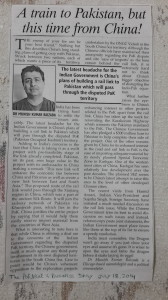The issue of Aadhaar Card is back in news. There is a report in the newspapers that Nandan Nilekani, former Chairman of Unique Identification Authority of India (UIDAI), recently met the Prime Minister Mr. Narendra Modi and Finance Minister Mr. Arun Jaitely and stressed upon the need to continue with the implementation of Aadhaar Card. As we know, the concept of Aadhaar cards was initiated by the UPA government and for that purpose; the Unique Identification Authority of India (UIDAI) was set up by Prime Minister Manmohan Singh. Mr. Nilekani was appointed as the first Chairperson of UIDAI. BJP had in its election campaigning opposed the UIDAI project. Per reports, the Prime Minister Mr. Modi has now shown inclination to continue with this project.
The system of allocating an Aadhaar Number (Card) has an immense value. Let every Indian be identified and allotted a number. Link it to financial account and Driving License and/or State-issued ID of the person. Then gradually scrap other means of IDs like ration card, PAN number and voter card. At the end, we shall be (in a few years, say) left with: 1. Aadhar Number and 2. A State -issued photo-identification card (eg: Driving License or Simply a Photo-ID). This would remove redundancy and bring uniformity in identifying a citizen.
USA has pretty much the same system (Social Security Number/SSN AND a state-issued DL/ID Card). A Social Security Number is a 9 digit number allotted to a person and carries until death. The concept of issuing a SSN was started in 1930s and has worked well for USA. The duo of SSN and a DL/State ID is a powerful tool to identify a person when it comes to financial accounts and dealings, admission to schools or colleges, employment (read taxes) and obviously background check (hence criminal background too). Thus, one may live in the costliest downtown of Manhattan (New York City) or the extreme border village in Alaska state ( literally touching the borders of Russia) or a remote village in the mountains of Montana state, everyone (who chooses to apply for) would have a SSN, and thus identifiable by the government.
In fact, Aadhaar Number is based upon the same concept of SSN. You get a number issued by the government and you keep it until the physical existence on earth!
Some activists have raised issues about the privacy rights and are opposing Aadhaar cards. I would say that their apprehensions are misplaced. No one should be forced to apply for an Aadhaar card and one is free to live in a vacuum.
The Aadhaar card system will work fine for us. Let us shed our doubts and take a firm path towards attaining a uniform system of identifying the citizens of the country.


